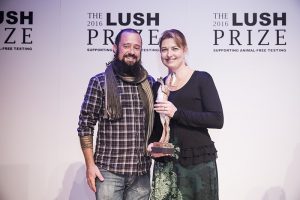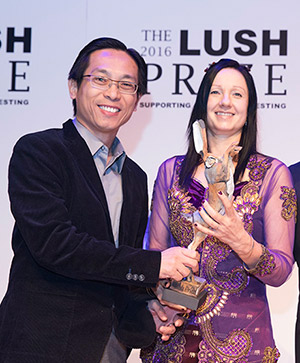2016 Prize Winners
The winners of the 2016 Lush Prize represent 20 projects from 11 countries, and we are delighted to have our first winners from China, South Korea and the Middle East.
One other project was commended by the judges.
The awards were presented at separate ceremonies in London, Vancouver and Seoul.
LOBBYING
1R Institute of Promotion and Research for the Replacement of Animal Experimentation
Brazil
http://www.Instituto1R.org
£40,000
 In November 2015, the 1R Institute, supported by Brazilian Network for Humane Education (RedEH)’s members, requested that the National Council for Control of Animal Experimentation (CONCEA)/Ministry of Science, Technology and Innovation (MCTI) recognise Conscientious Objection.
In November 2015, the 1R Institute, supported by Brazilian Network for Humane Education (RedEH)’s members, requested that the National Council for Control of Animal Experimentation (CONCEA)/Ministry of Science, Technology and Innovation (MCTI) recognise Conscientious Objection.
The request incorporated items for the protection of students and to avoid the desensitisation and promotion of speciesism among future scientific professionals. It included the recognition of Conscientious Objection, the non-obligatory participation in classes with harmful animal use and the development of internal mechanisms to offer support to Conscientious Objection students.
Between other delegations about animal experimentation in Brazil, CONCEA decreed that institutions using animal experimentation have the legal responsibility to offer alternative methods of evaluation for Conscientious Objectors, and the development of an Institutional ombudsman office for subjects related to animal use, including to support those students.
The 1R Institute is in contact with students in Brazil to spread the non-animal resources and also to promote new alternative methods for education and research projects. Also, the 1R Institute is following CONCEA’s decisions and requesting advances for the promotion of the replacement of animal experimentation, including working for a learning process based on an animal-free scientific paradigm.
People for Animals
India
http://peopleforanimalsindia.org
£10,000
 People for Animals strongly believe that the sacrifice of millions of lives in laboratories is entirely unnecessary.
People for Animals strongly believe that the sacrifice of millions of lives in laboratories is entirely unnecessary.
People for Animals were instrumental in establishing a regulatory body (CPCSEA) that resulted in a 30% reduction in the use of animals in the Indian medical industry. We worked to amend the Drugs and Cosmetics legislation to implement OECD guidelines for preventing the duplication of experiments and we stopped the killing of 9 million animals every year in schools for dissection.
In the past year, we have achieved a total replacement of animals for sensitivity and toxicity testing for detergents and other household products. Use of live animals in veterinary colleges to learn anatomy, pharmacology and physiology has been replaced with more updated methods of teaching.
At our request, the government sanctioned a substantial grant to build a model simulation laboratory in one of the leading colleges for alternatives. The Draize test, one of the most barbaric and unnecessary forms of cruelty, has finally been accepted as outdated by the Indian Government and a switch to alternatives is being made.
To get all this done, we lobby government agencies, appeal before the judiciary, get experts to work together and find solutions which are better for the government, people and for animals.
PUBLIC AWARENESS
Vshine Animal Protection Association
China
http://www.vshine.org
£50,000
 Vshine have taken our Be Cruelty Free campaign, to end animal testing for cosmetics (in support of the Humane Society International), across China. In just one year we visited over 160 universities and 30 provincial-level administrative regions, reaching nearly 300,000 college students.
Vshine have taken our Be Cruelty Free campaign, to end animal testing for cosmetics (in support of the Humane Society International), across China. In just one year we visited over 160 universities and 30 provincial-level administrative regions, reaching nearly 300,000 college students.
The campaign has received a wide reach on social media and in print. Activities have included:
- A tour of the Be Cruelty Free National College Poster Design Competition, covering 16 cities and 60 colleges and universities
- Be Cruelty Free National College publicity campaign, covering 18 provinces and 25 cities
- Nearly 300 people participated in our campaign at Dalian Maritime University to end animal experiments on World Day for Animals in Laboratories
Also Commended
ALTEX – Alternatives to Animal Experimentation
Switzerland
http://altex-edition.org

SCIENCE
Dr. Daniele Zink and Dr. Lit-Hsin Loo, Institute of Bioengineering and Nanotechnology and the Bioinformatics Institute of the Agency for Science, Technology and Research (A*STAR)
Singapore
http://www.ibn.a-star.edu.sg/
£10,000
 Animal-Free Methods to Predict the Toxic Effects of Chemicals on the Human Kidney
Animal-Free Methods to Predict the Toxic Effects of Chemicals on the Human Kidney
A research team led by Dr Daniele Zink from the Institute of Bioengineering and Nanotechnology and Dr Lit-Hsin Loo from the Bioinformatics Institute of the Agency for Science, Technology and Research in Singapore have developed animal-free methods that can accurately predict the toxic effects of chemicals on the human kidney.
The methods predict in particular toxicity for renal proximal tubular cells, which are important for the clearance of chemicals from the body.
The approaches combine human cell models, including stem cell-based models, with automated image analysis software and toxicity prediction by machine learning. The toxicity of different chemicals like drugs, industrial chemicals and natural compounds for renal proximal tubular cells could be predicted with an accuracy of 80-90%. This technology can also be applied to other human organs such as the liver, lung and blood vessels.
Animal testing is currently used to predict the toxic effects of chemicals used in many products. The goal of the Singapore research team is to offer an animal-free alternative for companies from the food, cosmetics, chemical and pharmaceutical industries to accurately predict the safety of their products.
Prof Marcel Leist, University of Konstanz / CAAT-Europe
Germany
https://www.uni-konstanz.de/en/university/
£40,000
 Our group focuses on the development of toxicological tests that are based on the use of human cells. Our vision is that eventually, when all these tests are established, the hazard can be predicted, based on an in vitro test battery.
Our group focuses on the development of toxicological tests that are based on the use of human cells. Our vision is that eventually, when all these tests are established, the hazard can be predicted, based on an in vitro test battery.
For safety evaluations, it is important that such a test battery captures all hazardous effects of chemicals, no matter which organ or which developmental phase they affect. For some target tissues (e.g. the liver or the skin of adults), the respective cells can be obtained relatively easily from donors or from commercial sources.
In other situations, this is difficult or virtually impossible (e.g. for neuronal cells or for cells that are only found in human fetuses, and that are important for normal development).
Our research projects aim at the generation of such rare cell types from pluripotent stem cells, to assure the quality of such cell preparations and to use the cells alone, or in combination with other cell types to establish test systems suitable for hazard testing of environmental chemicals and drugs.
In recent years, a major focus has been the development of 2D and 3D neuronal tissues, and on the set-up of test systems that allow predictions on chemical effects on normal neural development.
TRAINING
Kirkstall
UK
http://kirkstall.com/
£25,000
 Kirkstall – Saving lives through better scienceTM
Kirkstall – Saving lives through better scienceTM
Kirkstall is committed to installing our passion and eagerness for replacing animal testing into the mind-sets of researchers worldwide.
Changing researchers’ perspectives on animal replacement and in vitro testing is challenging. Many researchers are not even aware that alternatives exist, so we must improve their awareness. Kirkstall is achieving this through training, often converting intrigued bystanders into supportive scientists.
Our training workshops provide an introduction to the theory and practice of all advanced cell culture techniques, ensuring attendees leave with a detailed understanding of how to replace animal testing with more effective, human-relevant research.
Training workshops are delivered by a team of experts through a combination of lectures, demonstrations and practical hands-on experience and have been hosted in labs across Europe and USA. Kirkstall supports this activity with a comprehensive programme of conference demonstrations, industrial company visits and workshops, alongside academic conferences and our own annual event, the Advances in Cell & Tissue Conference.
Kirkstall’s training programme has reached over 600 scientists. The recognition and financial reward gained from the Lush Prize presents us with a great opportunity to increase the impact of our training activity and our continued efforts towards the replacement of animal testing.
Iranian Anti-Vivisection Association
Iran
http://www.noanimaltesting.ir
£25,000
 The Iranian Anti-Vivisection Association (IAVA) has been working with universities for over six years, meeting with deans, teachers and students nationwide to demonstrate and introduce humane alternatives.
The Iranian Anti-Vivisection Association (IAVA) has been working with universities for over six years, meeting with deans, teachers and students nationwide to demonstrate and introduce humane alternatives.
Despite the challenging environment, our network has grown and our activity has increased – with some positive successes already achieved. We have held seminars and exhibitions of alternatives at many national and international veterinary conferences. We have a small library of alternatives and distribute free software and other alternatives at these events and directly to universities.
We also promote alternatives in research and testing. A number of publications about humane education and humane science have been translated into Farsi, with distribution nationwide to relevant universities and institutes. We are also lobbying the Ministries of Education, Health and Science to change the education system nationally, and the former has already called for veterinary universities to consider alternatives.
Direct replacement has now been achieved in a number of anatomy, surgery, physiology and pharmacology practical classes. In a country where animals, particularly dogs, are so little respected, the work of IAVA is of great importance. Critiquing animal experimentation, informing people about alternatives, and demonstrating that full replacement is achievable, is happening for the first time in Iran.
See an update on what IAVA has been doing between 2016 and 2018.
YOUNG RESEARCHER (AMERICAS)
The Americas awards were announced in Vancouver on 1st November.
You can find full details and video interviews with all five winners here.
The five winners were each awarded $15,000:
Kambez Hajipouran Benam, Harvard University, USA
Nicole Kleinstreuer, National Institute of Environmental Health Sciences, USA
Yu Shrike Zhang, Brigham and Women’s Hospital, USA
Kimberly Norman, Institute for In Vitro Sciences, USA
Daria Filonov, Creative Scientist Inc., USA
YOUNG RESEARCHER (ASIA)
The Asia awards were announced in Seoul on 17th November.
You can find full details of all five winners here, along with photos and videos of the event.
The three winners were each awarded £10,000:
Mijoo Kim, Yonsei University, South Korea
Kumiko Tatsumi, Osaka City University, Japan
Yu Chen, The Center for Alternatives Research & Evaluation, China
YOUNG RESEARCHER (REST OF WORLD)
Giorgia Pallocca, University of Konstanz
Germany
£10,000
The developmental toxicity testing is a sensitive topic. If a woman is exposed to dangerous compounds during pregnancy, she may be not affected, but the fetal development may be impaired.
In particular, my project aims to predict toxic effects of environmental pollutants and clinical drugs affecting the neural crest. These cells are a multipotent migratory population, crucial during human development, which must be able to move through the embryo to form different cell types, from sensory neurons to melanocytes.
We produce human neural crest cells by differentiating human pluripotent stem cells, and we study their functionality, e.g. their migration capacity, by in vitro assays. Studying the disturbance of the neural crest cell migration process by toxicants is important since interferences with this process are known to lead to severe pathologies in newborns.
Screening of a large number of substances led us to identify several potential developmental toxicants affecting neural crest mobility. The next step is to now identify the underlying molecular mechanisms of the observed effects.
In particular, my project aims at characterizing the mechanisms of toxicity of a cytokine, interferon beta, clinically used for the treatment of autoimmune diseases, to identify the events that lead from the receptor binding to the inhibition of migration of the neural crest cells.
Pranjul Shah, University of Luxembourg
Luxembourg
£10,000
 The human body is host to trillions of bacteria commonly known as the human microbiome. The human microbiome is now speculated to play a critical role in numerous diseases, for example diabetes, obesity, cancers, etc.
The human body is host to trillions of bacteria commonly known as the human microbiome. The human microbiome is now speculated to play a critical role in numerous diseases, for example diabetes, obesity, cancers, etc.
As current animal models fail to comprehensively mimic the human host and microbiome interaction, there is an imminent need for representative in vitro models that could replace such currently animal-based studies with extremely high failure rates.
We have designed a credit card sized system that is capable of reproducing any interface of the human body where bacteria reside and interact with the human body such as gut, lung, skin, etc. We first targeted the human gut and demonstrated that the system can mimic human responses previously highlighted in two separate human clinical studies.
We further demonstrated that our gut model was better at estimating human response to probiotic therapy than piglets.
These results corroborate the promise of such in vitro systems widely termed as organs-on-chip to minimise the global dependence on animal testing for development of food, pharma and cosmetic products among others.
Eleftheria Pervolaraki, University of Leeds
UK
£10,000
 My project concentrates on understanding human heart development using human volunteers, their datasets and computational modeling. I aim to answer how babies get arrhythmias in utero and how these defects may lead to sudden death.
My project concentrates on understanding human heart development using human volunteers, their datasets and computational modeling. I aim to answer how babies get arrhythmias in utero and how these defects may lead to sudden death.
Animal models have been used traditionally to study cardiac development and physiology. The Home Office reports the use of more than 132,000 mammals (ranging from rodents to farm animals and primates) yearly for cardiac research and the publication of around 1500 papers using data acquired from rodents, pigs and chicks.
In 2013, I published ground-breaking findings, which gained worldwide publicity, demonstrating that animal models are not always appropriate for understanding human development due to their different physiology and developmental time-line.
With this project, I recruit volunteers through the NHS and I utilise their datasets in combination with computer models to understand human heart physiology in utero and map its development. The long-term aim of my work is to produce tools that will be better able to allow obstetricians to identify abnormal heart development during routine prenatal scans.
Through my publications, I will ensure that animal replacement is achieved not only within my lab but also at a national and international level. My work has already received international attention and through my outreach activities I continue to promote the benefits of animal-free research.
Katherine Chapman, Swansea University
UK
www.swansea.ac.uk/medicine
£10,000
 All new chemicals require safety testing prior to their use in products and treatments. An important aspect of this testing relates to DNA damage, as this is a major cause of cancer.
All new chemicals require safety testing prior to their use in products and treatments. An important aspect of this testing relates to DNA damage, as this is a major cause of cancer.
Initial tests to determine whether a chemical causes DNA damage involve simple, cell culture-based tests using cells isolated from animals or humans, or bacterial cells. If the chemical damages DNA in these cells, then it is taken forward to animal-based tests to observe whether it causes cancer.
However, existing in vitro tests sometimes over-estimate the effect of chemicals, leading to unnecessary animal follow-up tests.
My PhD involved working to improve the current initial, cell-based tests by using longer-term chemical treatments, 3D skin models, low doses and human cells. More recently, my postdoctoral position has involved developing a test that could potentially contribute to the replacement of the two-year rodent cancer bioassay.
Together, it is hoped that these changes will lead to effective safety testing without animals.
Antje Appelt-Menzel, University Hospital Würzburg
Germany
£10,000
 Within my PhD project I was able to develop an improved human in vitro model of the healthy blood-brain barrier (BBB) using a human induced pluripotent stem cell (hiPSC) source.
Within my PhD project I was able to develop an improved human in vitro model of the healthy blood-brain barrier (BBB) using a human induced pluripotent stem cell (hiPSC) source.
In general, the BBB presents one of the tightest and most important barriers between the blood circulation and the central nervous system (CNS). It mainly serves to maintain the homeostasis of the CNS and for protection against neurotoxic substances and pathogens, such as bacteria and viruses.
For the development of drugs applied for the treatment of neurodegenerative diseases, such as Alzheimer’s disease, the tightness of the BBB towards substances and the high metabolic activity of the endothelial cells pose a problem.
More than 90% of the CNS drugs that are developed cannot be successfully marketed after the first-in-man studies, even though they were already tested on animals or with cell lines. A better effectiveness of compounds could be determined by an application-oriented usage of drugs in disease-specific dysregulated BBB models.
The hiPSC technology enables the possibility to develop patient and tissue-specific in vitro disease models as well as the generation of more effective personalized therapies and novel drugs.






























Spread the word: